The global stock market is evolving faster than ever, and artificial intelligence is leading this transformation. AI trading bots execute trades in milliseconds, while predictive algorithms detect market signals invisible to humans. AI-powered stock trading apps help traders make smarter, faster decisions and deliver more consistent results for investors.

So, if you plan to integrate AI into the stock trading app, this blog will help you understand the approaches, challenges, and use cases.
Let's first start with its brief introduction!
What is an AI-Powered Stock Trading App?
AI stock trading app uses machine learning, sentiment analysis, and complex algorithmic predictions to understand complex and dynamic stock market activity, data processing, and data classification. It also helps to identify millions of data points and execute trades at great prices.
Artificial Intelligence traders also analyze forecast markets accurately and efficiently to mitigate risks and provide higher ROI.
Here are several types of AI stock trading apps:
- Quantitative trading
- Algorithmic trading
- High-frequency trading
- Automated trading
Why Should You Integrate AI into Your Stock Trading App?
Here are several reasons why you should AI integration in business processes for your stock trading app development:

Improve Accuracy with Less Research Time
With AI-powered algorithms in their trade executions, investors may efficiently save time. They can also manage their transactions, give customers professional advice, quickly automate research procedures, and utilize data-driven strategies.
According to recent research, algorithmic approaches boost productivity by as much as 10%.
What else? Past financial data improves the quality of advice, thus increasing both accuracy levels while lowering the possibility of mistakes that can occur during trade executions owing to human participation.
Forecast Patterns
With sentiment analysis integration, AI-powered stock trading can gather different textual and linguistic data to analyze patterns depending on objective material. Artificial Intelligence solutions in stock trading systems can determine distinctive market swings and fluctuations by identifying and inspecting news outlets and social media platforms.
Minimize Costs
Implementing advanced technology like AI in stock trading apps can automate some activities that may be repetitive for their human workforce.
Although there could be short-term financial ramifications for adopting this new system and paying for its upkeep, businesses, and investors can save a lot of money by using it.
The benefit of AI algorithms is that they are configured to operate constantly without taking pauses. They enable continual 24/7 stock market monitoring and long-term cost-effective advtanges.
What are Core AI Technologies in Trading Platform?
Integrating AI into a stock trading app requires advanced technologies that power intelligent decision-making, speed, and precision. Here are the key AI technologies driving modern trading platforms:
1. Machine Learning (ML)
Machine Learning algorithms analyze vast amounts of historical and real-time market data to identify patterns and predict price movements. In trading apps, ML models can fine-tune strategies based on evolving market trends, improving accuracy over time.
2. Deep Learning (DL)
Deep Learning uses neural networks with multiple layers to detect complex patterns in data. In trading, DL enables advanced market forecasting, sentiment analysis, and risk management by processing both structured and unstructured data.
3. Natural Language Processing (NLP)
NLP helps trading platforms interpret and act on financial news, earnings reports, and social media sentiment in real time. This technology allows apps to extract market-moving insights from unstructured text, giving traders a competitive edge.
4. Reinforcement Learning
Reinforcement Learning uses trial-and-error-based algorithms to develop adaptive trading strategies. These models learn from every decision and adjust in real time, making them ideal for volatile market conditions.
By combining these AI technologies, stock trading apps can provide smarter trade execution, real-time insights, and improved risk management. It delivers tangible value to both novice and professional traders.
AI Use Cases in Stock Trading App
Let’s explore applications of artificial intelligence powered stock trading app:
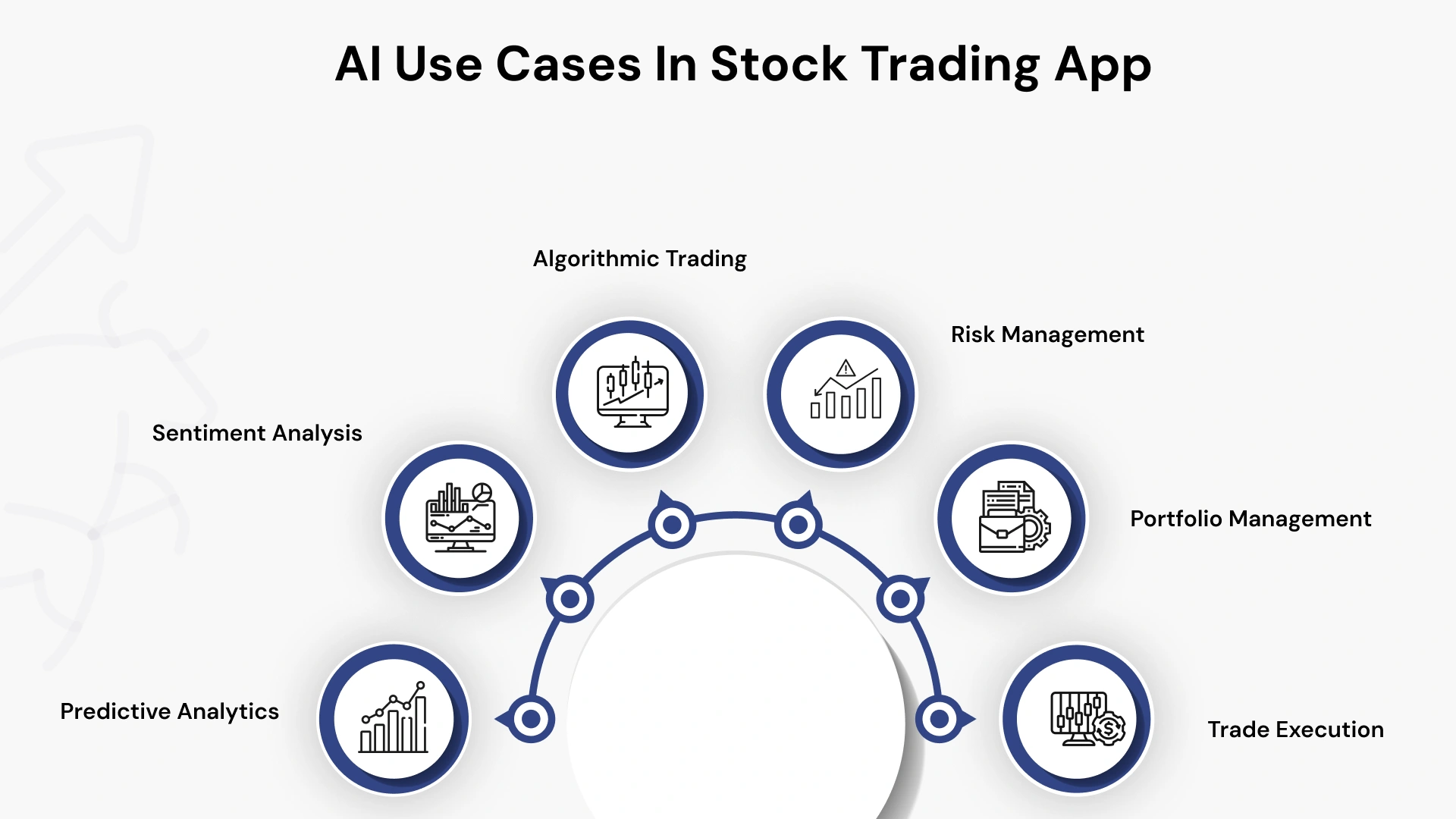
Predictive Analytics
One of the most effective uses of artificial intelligence in stock trading is predictive analytics. The ability of AI systems to swiftly identify patterns that people would miss when studying enormous volumes of historical data allows traders to make more informed and precise investment decisions by using this data to predict future stock values.
Predictive analytics enabled by AI has the potential to significantly improve trading tactics, reduce risks, and increase overall profitability.
Sentiment Analysis
AI is helpful in the stock market by performing sentiment analysis. These AI algorithms can gauge public sentiment in real-time by scanning news articles, social media posts, and other information sources to determine sentiment toward specific stocks or the market as a whole.
It gives traders invaluable insight into investor behavior and a deeper understanding of market sentiment and investor behavior, allowing them to make more informed decisions and take advantage of market sentiment.
Algorithmic Trading
The use of AI has transformed algorithmic trading. Artificial intelligence (AI) offers traders sophisticated algorithms capable of responding to changing market circumstances and making real-time trading choices. Algorithmic trading employs pre-programmed trading instructions to execute transactions automatically by specific established criteria.
Additionally, these cutting-edge AI-powered systems can analyze enormous volumes of data at speeds that humans cannot match; this automation boosts productivity and reduces mistakes and emotions that come with trading.
Risk Management
Effective risk management in stock trading is crucial to safeguard assets and reduce losses, with artificial intelligence playing a critical role. AI algorithms have shown to be extremely useful for controlling risks by examining past market volatility, liquidity indicators, and other possible indications to create risk reduction techniques.
AI-driven risk monitoring systems offer real-time risk monitoring, warning traders of potential hazards and recommending actions they should take to prevent them.
Portfolio Management
An intricate process requiring in-depth knowledge of both market dynamics and specific equities is portfolio optimization. By evaluating massive volumes of data and making wise suggestions, artificial intelligence can help traders manage their portfolios.
AI algorithms can pinpoint the best asset allocation techniques, assess the performance of particular stocks, and provide recommendations for diversification, assisting traders in making data-driven choices to get the most out of their portfolio investments.
Trade Execution
Similarly, AI has transformed how trades are executed in the stock market. Thanks to AI algorithms, traders may now place transactions at the best pricing with the least amount of slippage.
AI-powered trade execution systems examine market liquidity, order book data, and other criteria. This automation saves time and boosts efficiency while lowering transaction costs.
Step-by-Step Guide: How to Integrate AI into a Stock Trading App
Integrating AI into a stock trading app requires a structured approach to ensure accuracy, compliance, and performance. Below is a detailed roadmap for building an AI-powered trading platform that meets market demands and regulatory standards.
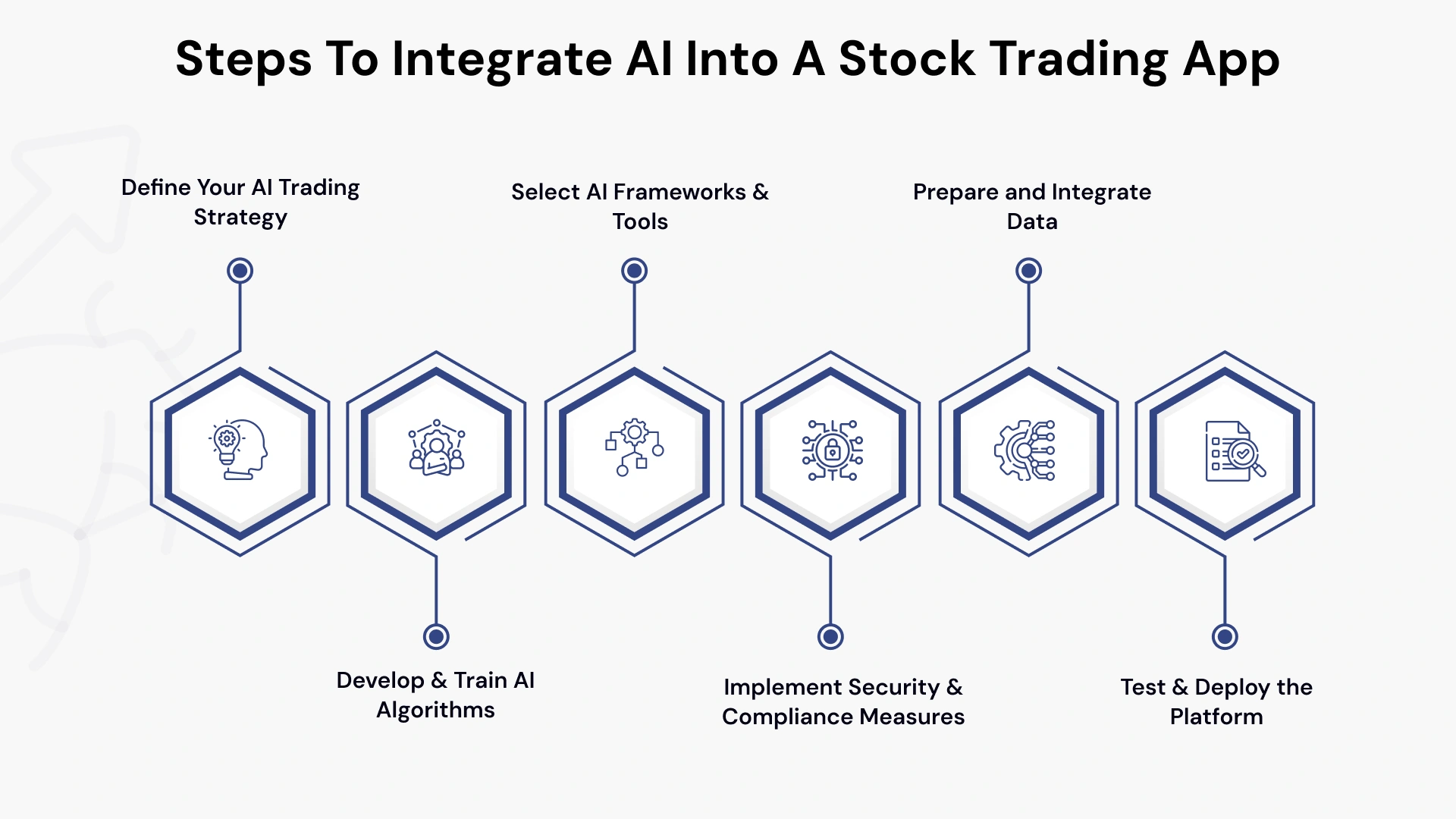
Define Your AI Trading Strategy
Before starting development, it’s crucial to define the scope and purpose of your AI-powered trading platform. Decide whether your app will focus on day trading, swing trading, or long-term investing.
Set measurable performance goals such as;
- Achieving a 15% annual ROI
- Reducing trade execution time by 50%
- Improving the win-to-loss ratio by 20%
Additionally, identify your target audience, whether it’s retail traders, hedge funds, or institutional investors. So, you can align the AI features with their trading needs.
2. Select AI Frameworks & Tools
Choosing the right technology stack ensures scalability, performance, and adaptability for your AI trading app. Python is popular programming language in AI development thanks to its extensive libraries and frameworks.
Tools like TensorFlow and PyTorch are ideal for building and training machine learning and deep learning models.
For market data, APIs such as Alpha Vantage, Yahoo Finance, and Polygon.io provide both historical and real-time feeds. Cloud services like AWS, Azure, or Google Cloud can handle AI model training, deployment, and storage needs efficiently.
3. Prepare and Integrate Data
AI models rely on accurate and comprehensive data to deliver meaningful insights. Gather large volumes of historical stock prices, trading volumes, economic indicators, and sentiment data from trusted sources.
Go beyond traditional data by integrating alternative sources like news feeds and social media sentiment to capture a fuller market picture. Clean and normalize the data to remove errors, fill missing values, and maintain consistent formats.
Building an automated data pipeline will help continuously feed updated data to your AI models for real-time predictions and strategy adjustments.
4. Develop & Train AI Algorithms
With data in place, the next step is creating algorithms that can predict market trends and execute trades effectively. You might use regression for price forecasting, reinforcement learning for strategies, or NLP for sentiment-based trading decisions.
Backtest your algorithms using at least five years of historical data to validate their effectiveness. Focus on optimizing accuracy, reducing latency, and improving the Sharpe ratio for better risk-adjusted returns. Make sure to retrain and fine-tune the models regularly so they adapt to changing market conditions.
5. Implement Security & Compliance Measures
Security and compliance are non-negotiable in stock trading platforms. Protect user data with TLS 1.3 encryption for data transfers and AES-256 encryption for stored information. Ensure your app complies with financial regulations like SEC and FINRA in the U.S. and GDPR in the European Union.
Implement AI-driven fraud detection systems to spot suspicious trading activity in real time. These measures not only safeguard your platform from cyber threats but also help build trust with traders and investors.
6. Test & Deploy the Platform
Thorough testing is essential before launching your AI-powered trading app. Conduct stress tests under high-volatility scenarios to ensure your system remains stable and responsive. Evaluate performance metrics such as prediction accuracy, order execution speed, and user experience during beta testing.
Once deployed, continuously monitor system performance and retrain your AI models with fresh market data to maintain high efficiency and profitability. A strong post-launch maintenance plan will keep your trading platform competitive and reliable in fast-changing markets.
If you want to know how to integrate AI chatbot into your website, read the process!
Best AI Trading Bot Development Approaches
For enterprises in the trading sector, choosing the right AI trading bot development approach is not only a technical decision. It’s a strategic investment that directly impacts ROI, risk exposure, and market competitiveness.
Here are the most effective approaches to consider when integrating AI into your stock trading platform.
1. Rule-Based AI with Machine Learning Enhancements
A hybrid approach that combines predefined trading rules with adaptive ML algorithms can be ideal for maintaining compliance while improving performance over time.
Rule-based frameworks ensure transparency and regulatory alignment, while ML continuously refines strategies based on live market data.
2. Reinforcement Learning for Self-Optimizing Strategies
Reinforcement Learning (RL) enables trading bots to learn from trial and error, adapting to market changes without human intervention. By continuously adjusting trading parameters based on real-time feedback, RL-driven bots can outperform static strategies.
3. Natural Language Processing (NLP) for Sentiment-Driven Trading
NLP-driven bots can analyze financial news, social media feeds, and analyst reports to detect early market signals. These insights help anticipate market shifts before traditional indicators react.
4. Cloud-Native, API-First Development
For enterprises aiming for scalability and rapid deployment, a cloud-native, API-first development model is the most efficient. It allows seamless integration with data providers, brokerage APIs, and compliance systems. This approach ensures faster time-to-market while supporting global scalability.
5. Backtesting-First Development Cycle
Enterprise-grade AI trading bots must be rigorously tested before going live. A backtesting-first approach validates the algorithm’s resilience across various market conditions. It helps fine-tune performance metrics such as Sharpe ratio, drawdown, and ROI.
6. Security-Embedded Design
With cyber threats targeting financial systems, security must be built into the bot’s architecture from day one. This includes following things to protect trading logic and user data:
- Encrypted communications
- Secure authentication protocols
- AI-powered fraud detection mechanisms
When combined strategically, these approaches enable enterprises to build AI trading bots that execute trades at lightning speed. They also ensure long-term profitability, regulatory compliance, and a sustainable competitive edge.
Case Studies: Successful AI Stock Trading App Implementations
Real-world examples speak louder than theory. Here are notable success stories showing how AI integration can transform stock trading performance, risk management, and profitability.
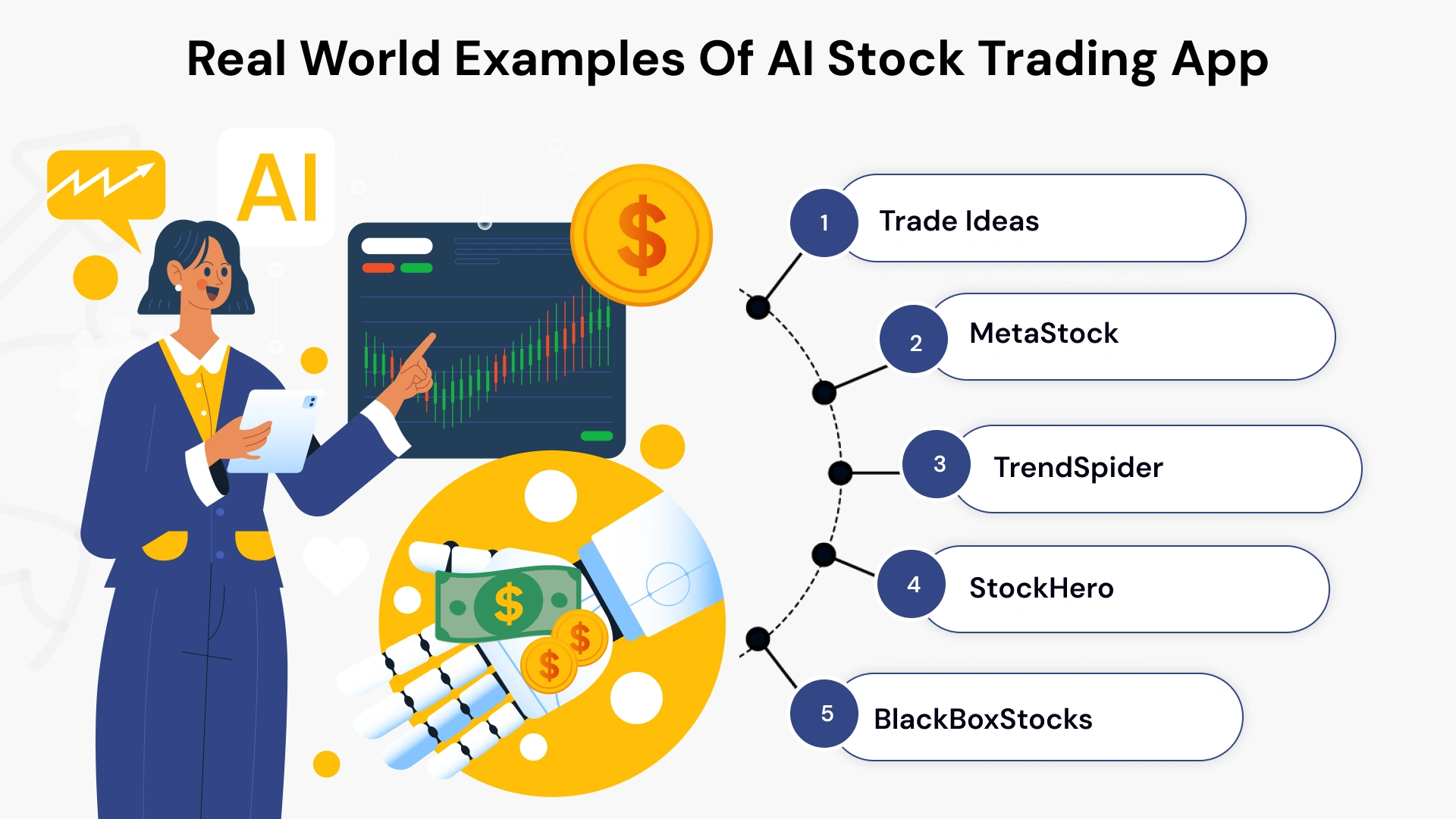
1. Trade Ideas – AI-Powered Trade Discovery
Traders needed faster, more accurate trade opportunities without sifting through endless market data.
AI engine Holly analyzes millions of data points daily, identifying high-probability trade setups based on historical and real-time patterns.
Result: Users reported improved trade accuracy, with some institutional traders increasing their win rate by 25% within the first quarter.
2. MetaStock – Predictive Market Analysis
Institutional clients struggled with predicting market turns accurately during volatile conditions.
Leveraged AI-powered forecasting models that combine technical, fundamental, and sentiment analysis.
Result: Traders using MetaStock’s AI tools improved portfolio returns by an average of 15% year-over-year, even in fluctuating markets.
3. TrendSpider – Automated Technical Analysis
Manual chart analysis consumed excessive time, leaving room for human error.
AI-driven algorithms automatically detect trend lines, Fibonacci levels, and chart patterns in real-time.
Result: Reduced analysis time by 70%, enabling traders to make faster and more confident decisions.
4. StockHero – AI Trading Bot Platform
Retail investors lacked the resources to run complex automated trading strategies.
Provided customizable AI bots that adapt to changing market conditions without user coding.
Result: Over 60% of active users reported achieving more consistent returns and better risk management.
5. BlackBoxStocks – AI for Day Trading
Day traders needed split-second decision-making capabilities.
Integrated AI scanning tools to monitor market activity and identify unusual volume spikes and momentum plays instantly.
Result: Improved daily trade execution speed by 40%, directly boosting profitability for active traders.
Best AI Trading Bots & Platforms: Free vs. Paid Comparison
The market for AI trading bots offers a wide range of solutions, each designed for specific trading styles and objectives. If you’re planning to integrate AI into their stock trading platforms, selecting the right tool can accelerate market entry and deliver measurable ROI.
Here’s a breakdown of top five AI trading bots & platforms based on free or paid:
| Platform | Best For | Key Features | Pricing | Ideal Users |
| MetaStock | AI Stock Trading Prediction | Predictive analytics, market forecasting, backtesting, global market coverage | Paid (subscription) | Hedge funds, institutional traders, long-term investors |
| Trade Ideas | AI-Based Stock Trading | Real-time trade ideas, backtesting, auto-trading via Brokerage Plus | Paid (monthly/yearly) | Professional traders, proprietary trading firms |
| TrendSpider | Automated Technical Analysis | AI trendline detection, multi-timeframe analysis, automated charting | Paid (subscription) | Swing traders, technical analysts |
| StockHero | Creating AI Stock Trading Bots | Bot builder, strategy testing, cloud deployment, paper trading | Free & Paid tiers | Fintech startups, custom strategy developers |
| BlackBoxStocks | Day Trading | Real-time market scanning, options flow tracking, momentum trading alerts | Paid (subscription) | Day traders, active retail traders |
Maximize ROI: Benchmark AI Trading Performance Against Top Competitors
For decision-makers in the competitive stock trading ecosystem, ROI is the ultimate litmus test for any new technology investment—including AI integration. Deploying AI into your stock trading app isn’t just about automation or predictive analytics; it’s about outperforming the competition at scale.
By benchmarking your AI trading performance against leading market players, you can identify critical gaps in speed, accuracy, and profitability. This comparative analysis enables your leadership team to:
- Quantify Performance Gains: Evaluate AI-driven trading execution times, win rates, and portfolio returns against industry leaders.
- Spot Missed Opportunities: Identify underutilized datasets or algorithms where rivals are achieving higher returns.
- Set Aggressive Yet Realistic Targets: Use competitor benchmarks to define KPIs that push your AI engine toward market leadership.
- Validate Technology Investments: Justify ongoing AI budget allocations by demonstrating measurable ROI compared to top-tier platforms.
Forward-thinking enterprises leverage real-time market data, algorithmic audit trails, and peer performance metrics to not only match but surpass industry standards.
When AI performance outpaces competitors, it doesn’t only mean higher profits. It enhances market credibility, makes client acquisition strong, and increases sustainable growth.
Pro Tip: Partner with an AI solutions provider experienced in both fintech compliance and high-frequency trading optimization to ensure your benchmarks are realistic, regulatory-friendly, and profit-driven.
Challenges You Can Face When Integrating AI into the Stock Trading App
From cybersecurity threats and scalability hurdles to regulatory complexities and ethical concerns, the stakes are high. If not addressed strategically, these challenges can lead to reputational damage, financial loss, and regulatory penalties.
Here are the key challenges of AI integration in a stock trading app along with solutions:
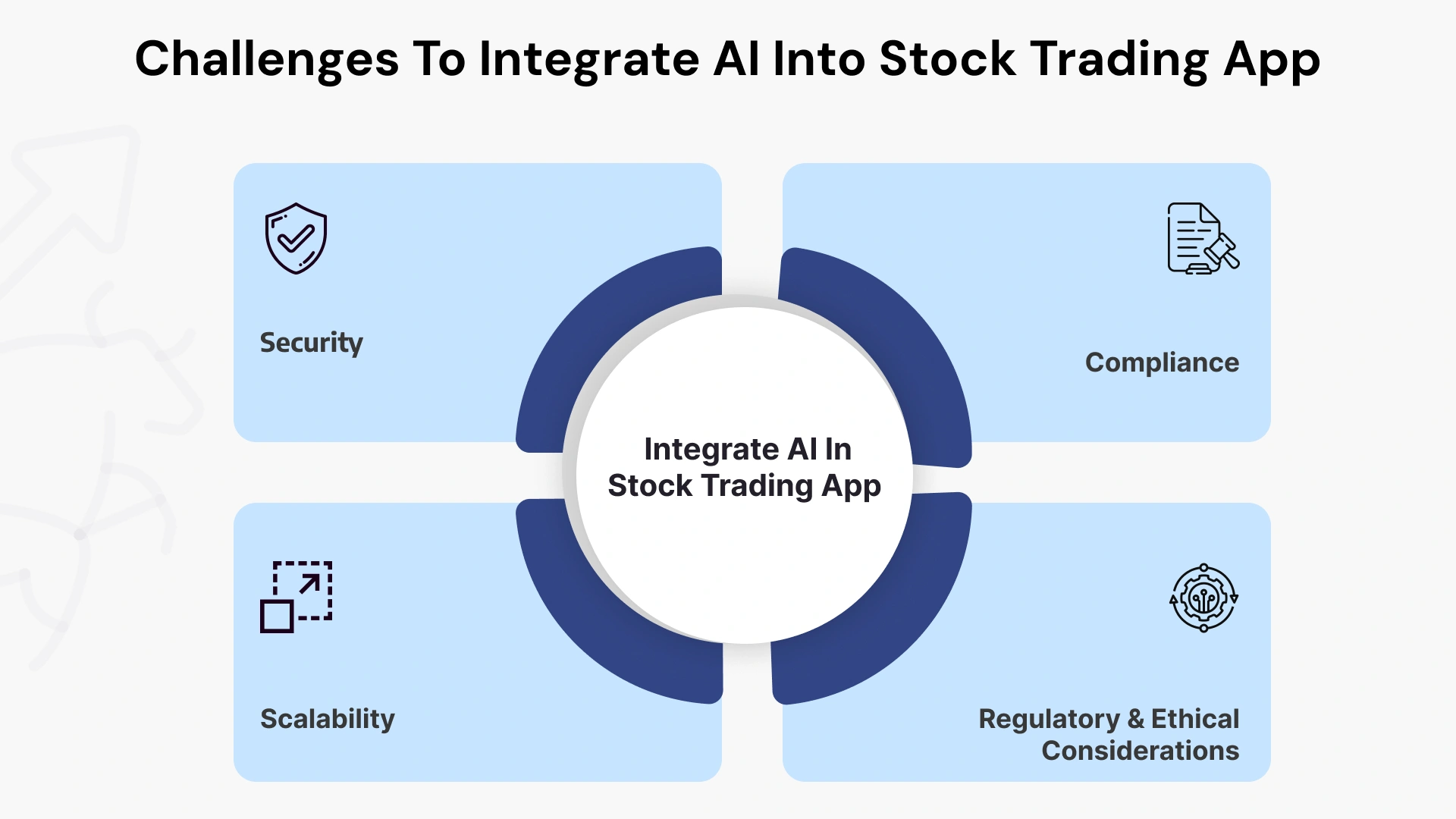
Security
AI-powered stock trading apps deal with vast volumes of highly sensitive financial data, including user credentials, portfolio details, and transaction histories. A single breach can compromise investor trust and trigger legal consequences. AI systems can also be exploited through data poisoning or adversarial attacks.
How to Overcome It:
We implement multi-layered cybersecurity frameworks, including;
- End-to-end encryption
- AI-driven anomaly detection
- Multi-factor authentication (MFA)
- Intrusion detection systems (IDS)
Our AI models use secure, clean datasets and undergo continuous threat simulation testing to identify and fix vulnerabilities.
2. Scalability
As your user base grows, the AI engine must process more market data in real time without performance degradation. Poor scalability leads to latency in trade execution—potentially costing millions in missed opportunities.
How to Overcome It:
We design cloud-native, microservices-based architectures that allow AI models to scale horizontally and handle massive concurrent trading requests. By leveraging GPU-accelerated computing and edge AI processing, our solutions ensure real-time analytics and lightning-fast trade execution, even under peak trading volumes.
3. Compliance
Stock trading platforms must meet FINRA, SEC, and MiFID II standards, as well as anti-money laundering (AML) and know-your-customer (KYC) requirements. AI integration can unintentionally breach these rules if not handled carefully.
How to Overcome It:
We build AI models with explainable AI (XAI) capabilities so every decision is transparent and traceable for audit purposes. Our compliance experts ensure end-to-end adherence to financial regulations and embed automated reporting features for regulators.
4. Regulatory & Ethical Considerations
AI-driven trading must comply not only with regional regulations and global industry standards like;
- SEC
- FINRA
- MiFID II
- ISO 27001 for information security
- ISO/IEC 38507 for AI governance
At the same time, platforms face ethical challenges including;
- Market manipulation risks
- Bias in decision-making
- Fairness in trade execution
Regulators are increasingly demanding transparency and accountability in algorithmic trading systems.
How TO Overcome It:
We integrate AI governance frameworks to ensure algorithmic fairness, bias mitigation, and ethical decision-making. Our development process includes compliance-by-design, continuous algorithm auditing, and model interpretability.
Choose VLink for Expert AI Integration in Your Stock Trading App!
VLink is one of the best AI & ML development companies with many years of experience delivering AI stock trading platforms integrated with algorithms, artificial intelligence, and machine learning technologies. Our professionals can turn your idea into AI stock trading software personalized to your unique business needs.
We help startups and established organizations shift their functioning from profitable to a reliable supplier of trading solutions. You can contact us for more information about integrating AI into the stock trading app!





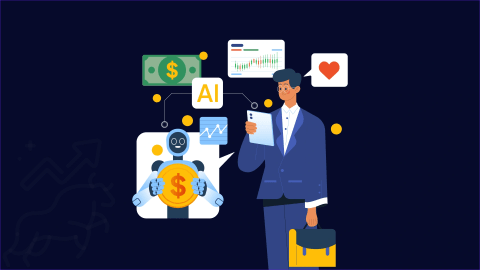



 Shivisha Patel
Shivisha Patel
















